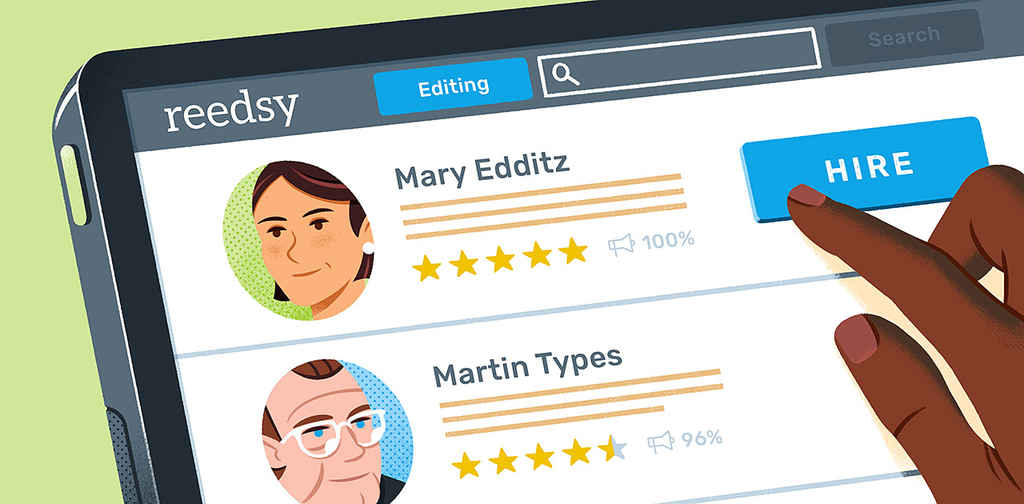Hire Developmental Editors near Oakland
Hire top professional developmental editors in Oakland. Refine your book's content in three easy steps: sign up, upload your project brief, and request quotes from professionals of your choice!
Hire top professional developmental editors in Oakland. Refine your book's content in three easy steps: sign up, upload your project brief, and request quotes from professionals of your choice!
Oakland, CA, USA
I am a seasoned (pun intended) editor working on cooking, health and wellbeing, and DIY/craft titles.
Work experience:
Services: Editing Developmental Editing Copy Editing Editorial Assessment Query Letter Review
Genres: Cooking, Food, Wine, & Spirits, Non-Fiction, DIY & Crafts, Health & Wellbeing
Oakland, CA, USA
I am a literary agent and freelance developmental book editor. I also edit and consult on query letters and non-fiction book proposals.
Work experience:
Services: Editing Developmental Editing Editorial Assessment Query Letter Review
Genres: History, Humanities & Social Sciences, Non-Fiction, Biographies & Memoirs, Political Science & Current Affairs, Historical Fiction, Fiction, Women's Fiction, Writing & Publishing, Young Adult, Literary Fiction
Oakland, CA, USA
Experienced content and copy editor of academic non-fiction (10+ years). A resource for your scholarly and creative projects.
Work experience:
Services: Editing Developmental Editing Copy Editing Proofreading
Genres: Philosophy, Humanities & Social Sciences, Non-Fiction, History, Earth, Space, & Environmental Sciences, Math & Science, Life Sciences, Sociology
Portland, United States
Dedicated editor of children's books specializing in middle grade and YA fiction. Worked at HarperCollins, Disney-Hyperion, and Scholastic.
Work experience:
Services: Editing Developmental Editing Editorial Assessment Query Letter Review
Genres: Picture Books, Children's, Fiction, Middle Grade, Children’s Non-Fiction, Non-Fiction, Middle Grade Fantasy, Young Adult Fantasy, Young Adult
Seattle, Washington, United States
24+ awards in writing and editing • 30+ books edited • Specialties include nonfiction and poetry • Ph.D. student, lit and creative writing
Work experience:
Services: Editing Developmental Editing Copy Editing Editorial Assessment Proofreading
Genres: Literary Fiction, Fiction, Short Story, Poetry, Art, Humanities & Social Sciences, Non-Fiction, Business & Management, History, Nature, Children’s Non-Fiction
Missoula, United States
(She/they.) Over a decade of in-house and freelance editorial work for Big 5 publishers & private clients across genres.
Work experience:
Services: Editing Developmental Editing Copy Editing Editorial Assessment Proofreading
Genres: Romance, Fiction, Women's Fiction, Science Fiction, Epic Fantasy, Fantasy, Urban Fantasy, Cozy Mysteries, Mystery & Crime, Young Adult Fantasy, Young Adult, Biographies & Memoirs, Non-Fiction
Seattle, United States
Award-winning science writer, editor, and publishing consultant for high-profile media. Also produce videos, podcasts, and presentations.
Work experience:
Services: Editing Developmental Editing Editorial Assessment Query Letter Review
Genres: Computers & Internet, Non-Fiction, Technology, Engineering, Math & Science, Physics & Chemistry, Earth, Space, & Environmental Sciences, Engineering & Materials Science, Life Sciences
Chicago, United States
Experienced developmental book editor specializing in parenting books as well as children's PB, MG and YA fiction.
Work experience:
Services: Editing Developmental Editing Editorial Assessment
Genres: Young Adult, Fiction, Middle Grade, Children's, Parenting & Families, Non-Fiction
Create your Reedsy account to get started.
Sign in with Google
We can help build a personalized team for your needs.
Developmental editors dive into the complex issues of your book, from plot holes to character development. They help you identify flaws by asking you tough questions about plot plausibility, pacing, and structure using their years of experience editing other books in the same genre. With a developmental editor's help, you can bring out the best elements of your work and really make them shine, while learning to let go of unnecessary scenes or wordy passages.
The developmental editors on our marketplace have all been carefully vetted, so you can rely on their expertise. Sign up today to browse developmental editors in Oakland and find the right editor for you.
Successful authors build talented teams around them to bring their book to life. Through the Reedsy Marketplace, you can meet the industry’s top professional book editors, cover designers, book marketers and ghostwriters. Reedsy professionals know the publishing landscape better than a writer knows the taste of hot coffee, come meet them. Create your free Reedsy account and start requesting free quotes and honest advice today.